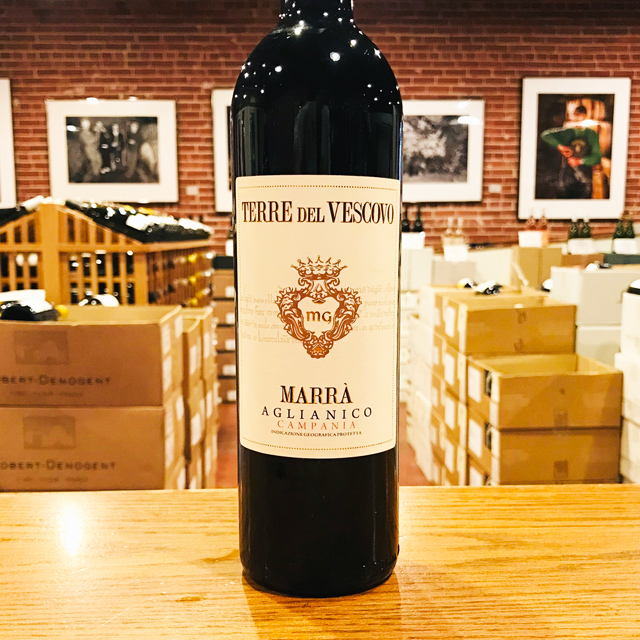Notify me
2013 Aglianico “Marrà”
Terre del Vescovo
Jam-packed with juicy blackberry, black cherry, and violets. Bring on the pizza napoletana, or chill it down for a warm-weather barbecue!
| Wine Type: | red |
| Vintage: | 2013 |
| Bottle Size: | 750mL |
| Blend: | Aglianico |
| Appellation: | Campania IGP |
| Country: | Italy |
| Region: | Campania |
| Producer: | Terre del Vescovo |
| Vineyard: | Planted in 2000 |
| Soil: | Clay, Limestone |
| Farming: | Sustainable |
| Alcohol: | 13.5% |
More from this Producer or Region

2017 Taurasi
Italy | Campania
A dense and chiseled Aglianico from old vines at elevation.

2015 Aglianico “Marrà”
Italy | Campania
Chewy and dark with loads of bloody, briary wild fruit, along with remarkable freshness, this is one of the best values we import from anywhere.

2016 Irpinia Campi Taurasini “Re‘na Vota”
Italy | Campania
It feels rustic but has polished tannins, deftly sustaining a racy core of inky black fruit.
 /
/
About The Producer
Terre del Vescovo
Terre del Vescovo is a 4-hectare property in Montemarano, a top cru of the Taurasi zone where the appellation’s highest-elevation sites yield chiseled, mineral, age-worthy reds. At up to 600 meters above sea level on soils of clay and limestone, the vines benefit from significant diurnal temperature shifts crucial to developing complex, well-defined flavors and preserving freshness at this southerly latitude. Thanks to this slow maturation, the late-ripening Aglianico is harvested in November, sometimes under a blanket of snow.
Giuseppa Molettieri cultivates these vineyards (many of them 60+ years old) with her husband Luigi, intent on preserving the tradition established by her father, Giovanni. He was the first of several generations of farmers in the family to bottle his wine and gain recognition for his Taurasi, and still watches over the vines and cellar to this day.
About The Region
Campania

Campania enjoys an ancient history as a fine wine producer—in fact, its precious nectars were highly coveted in ancient Rome and received accolades from many important writers of the era, including Pliny the Elder. While winemaking here dates back to the first Greek settlers to colonize the countryside, Campania is now enjoying a wine renaissance, as small farmers are relying less and less on the co-ops that dominated the scene for decades and increasingly turning to estate-bottling to make a living and capture the richness their territory has to offer.
The Mediterranean coastline, with bustling Napoli and towering Vesuvio as its focal point, is home to a number of light, simple wines from indigenous grape varieties, often planted in sandy volcanic soils. But Campania’s viticultural heartland lies further inland, in the Irpinia region around Avellino: this mountainous terrain offers altitude and limestone soils where the noble Aglianico, Fiano, and Greco are capable of producing what are arguably some of southern Italy’s most complex, characterful, and often age-worthy reds and whites.
The increasing number of artisanal producers bottling their own wine caught our eye several years ago, and today we count one Campanian grower among our ranks. With its deep winemaking traditions—not to mention world-famous specialties like mozzarella di bufala and pizza napoletana—we will undoubtedly return soon.
More from Campania or Italy
2021 Valle d’Aosta Traminer Aromatico
Château Feuillet Italy | Valle d’Aosta
2017 Toscana Rosso
Cuna di Federico Staderini Italy | Tuscany
2022 Vino Rosso
Cantine Elvio Tintero Italy | Piedmont
2021 Monferrato Rosso
Tenuta La Pergola Italy | Piedmont
2019 Venezia Giulia Gialloditocai MAGNUM
Vignai da Duline Italy | Friuli
2015 Aglianico “Marrà”
Terre del Vescovo Italy | Campania
2019 Verdicchio dei Castelli di Jesi Classico Riserva “Passolento”
La Marca di San Michele Italy | Le Marche
2016 Irpinia Campi Taurasini “Re‘na Vota”
Terre del Vescovo Italy | Campania
2017 Taurasi
Terre del Vescovo Italy | Campania
2021 Südtirol Eisacktaler Sylvaner
Manni Nössing Italy | Alto Adige
2021 Cannonau di Sardegna
“Barrosu”
Montisci Italy | Sardinia
2017 Alto Adige Merlot-Cabernet Sauvignon “Iugum”
Peter Dipoli Italy | Alto Adige
2021 Valle d’Aosta Traminer Aromatico
Château Feuillet Italy | Valle d’Aosta
2017 Toscana Rosso
Cuna di Federico Staderini Italy | Tuscany
2022 Vino Rosso
Cantine Elvio Tintero Italy | Piedmont
2021 Monferrato Rosso
Tenuta La Pergola Italy | Piedmont
2019 Venezia Giulia Gialloditocai MAGNUM
Vignai da Duline Italy | Friuli
2015 Aglianico “Marrà”
Terre del Vescovo Italy | Campania
2019 Verdicchio dei Castelli di Jesi Classico Riserva “Passolento”
La Marca di San Michele Italy | Le Marche
2016 Irpinia Campi Taurasini “Re‘na Vota”
Terre del Vescovo Italy | Campania
2017 Taurasi
Terre del Vescovo Italy | Campania
2021 Südtirol Eisacktaler Sylvaner
Manni Nössing Italy | Alto Adige
2021 Cannonau di Sardegna
“Barrosu”
Montisci Italy | Sardinia
2017 Alto Adige Merlot-Cabernet Sauvignon “Iugum”
Peter Dipoli Italy | Alto Adige
Kermit once said...

Kermit once said...
Let the brett nerds retire into protective bubbles, and whenever they thirst for wine it can be passed in to them through a sterile filter. Those of us on the outside can continue to enjoy complex, natural, living wines.
Inspiring Thirst, page 236














